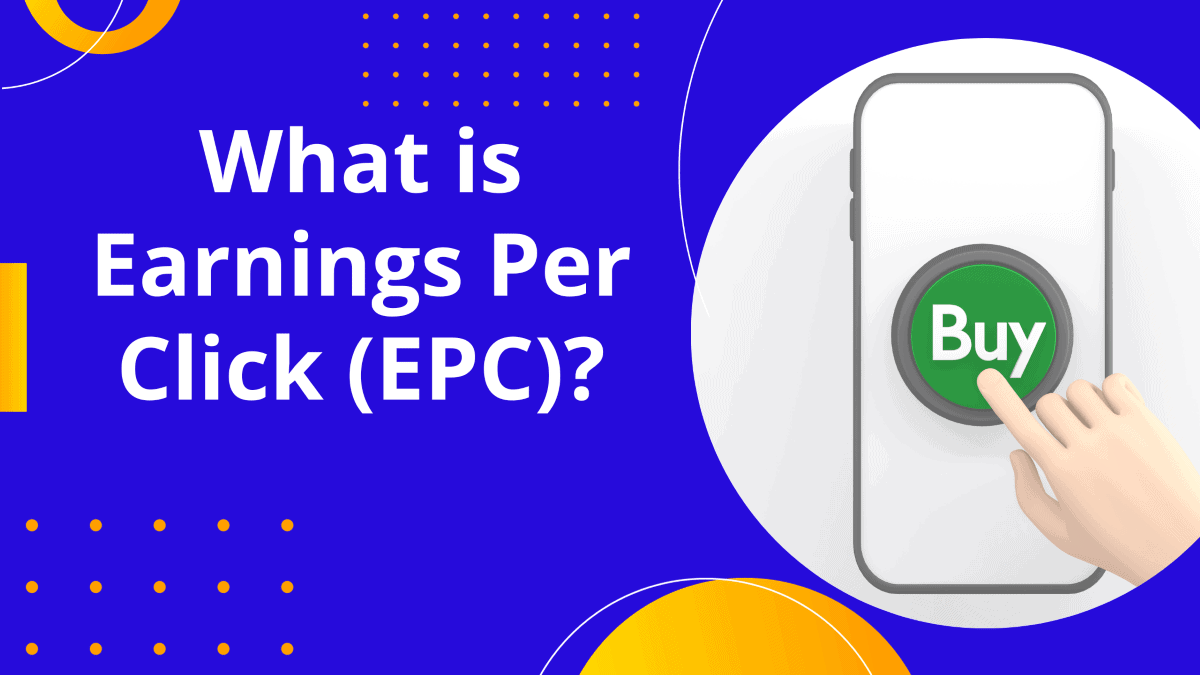
What Is Earnings Per Click (EPC) In Affiliate Marketing?
In the world of affiliate marketing, there’s a golden metric that shines bright – EPC which stands for Earnings per click.
Every click tells a story. It tells if your strategies work or if they need a change. Earnings per click (EPC) is not just a number. It’s a measure of success.
Why is it so vital?
Because it directly reflects your earnings. The higher the EPC, the better your performance.
Have you ever wondered how much each click is worth to you? Dive in, and let’s explore the importance of EPC in today’s digital landscape.
What does EPC mean in Affiliate Marketing?
EPC, or Earnings Per Click, is a specialized metric in affiliate marketing. At its core, earnings per click (EPC) quantifies the average earnings a marketer receives for every click generated through their affiliate links i.e. profit per click.
Think of it as a magnifying glass, zooming in on the financial value of every click you obtain.
It’s not strictly about the final affiliate sales but about evaluating the monetary potential each click presents.
How to calculate EPC?
Calculating EPC isn’t complex arithmetic.
You simply divide your total affiliate earnings by the total number of clicks on your affiliate links. This gives you an average earning per click.

In simple terms, it tells you about the value of a single click on your affiliate links.
For example, if you earned $300 affiliate commission from an affiliate program and it came from 150 clicks, your EPC is $2.
This calculation serves as a key indicator of both the quality of your traffic and the effectiveness of your affiliate links.
Importance of Earnings Per Click (EPC) in Affiliate Marketing Campaigns
Earnings per click (EPC) isn’t just another affiliate marketing term; it’s a reflection of your affiliate marketing prowess.
A high EPC indicates well-targeted traffic and a well-chosen affiliate program. It suggests that the audience is genuinely interested and finds value in what you’re promoting.
On the other hand, a low EPC can signal various issues. Maybe the traffic isn’t adequately targeted, or perhaps the affiliate offer isn’t compelling enough.
In essence, earnings per click (EPC) serves as a diagnostic tool. It helps pinpoint areas of improvement and guides optimization strategies, ensuring your efforts align with profitability.
How Earnings Per Click (EPC) Differs from Other Metrics
Metrics are the compass of digital marketing, guiding strategies and showcasing performance. While EPC offers an insightful lens into your affiliate marketing endeavors, it’s crucial to understand how it stands apart from other key metrics.
Each metric has its tale to tell, and knowing the differences ensures you’re interpreting the narrative correctly. Let’s explore how earnings per click is different from other metrics in affiliate marketing and why it is a better fit for affiliate marketers.
Difference between EPC (Earnings Per Click), CPC (Cost Per Click), and CPA (Cost Per Acquisition)
EPC (Earnings Per Click)
Definition: Represents the average earnings an affiliate marketer receives for every click on their affiliate link.
Focus: Earnings per click (EPC) centers on the earnings side of affiliate marketing. It’s about gauging profitability per click rather than costs or actions.
Application: Used primarily by affiliate marketers to evaluate the monetary potential of their links.
CPC (Cost Per Click)
Definition: Indicates how much an advertiser pays (on average) for each click on their advertisement.
Focus: Unlike EPC, CPC is all about costs. It’s a metric advertisers keep an eye on to ensure their ad spend is justified by the traffic they receive.
Application: Frequently used in paid advertising campaigns to control budgets and understand the efficiency of ad placements.
CPA (Cost Per Acquisition)
Definition: Measures how much it costs, on average, to acquire a customer or lead.
Focus: CPA is action-oriented. It delves deeper than just clicks, spotlighting the cost involved in achieving conversions, be it sales, sign-ups, or any defined action.
Application: Employed extensively in both affiliate marketing and broader digital marketing campaigns, helping marketers ensure they’re not overspending for their conversions.
Why Earnings Per Click (EPC) is a better metric for affiliate marketers?
Direct Insight into Profitability: While other metrics might offer broader views, earnings per click (EPC) directly correlates to the affiliate’s earnings. It’s like a health check for their revenue stream.
Focuses on Earnings, Not Costs: Unlike CPC, which emphasizes the cost per click, EPC (earnings per click) keeps the spotlight on earnings. This distinction is vital for affiliates, whose primary goal is to maximize revenue.
Indicative of Campaign Quality: A high EPC (earnings per click) can be indicative of well-chosen affiliate programs, effective promotional strategies, and high-quality traffic. Conversely, a low EPC can signal the need for strategic adjustments.
Holistic View: EPC (earnings per click) offers a blend of traffic quality and conversion success. While metrics like CPA might focus solely on the cost of conversion, EPC combines the value of clicks with the eventual conversion rate, offering a balanced perspective.
By understanding these distinctions and the unique position EPC holds, affiliate marketers can make more informed decisions and fine-tune their strategies for optimal profitability.
8 Ways to Increase Your Earnings Per Click (EPC)
After understanding the importance of EPC in the affiliate marketing landscape, the next logical step is optimization.
While a respectable earnings per click (EPC) indicates you’re on the right track, there’s always room for improvement. Elevating your EPC means amplifying your profits without necessarily increasing traffic. Let’s explore eight proven strategies to boost your EPC.

1. Promote Affiliate Links In High-Converting Displays
Your display methods significantly impact your click-through rates.
Utilize banner ads, pop-ups, or sidebars with compelling visuals and engaging content on your affiliate website.
The key is to capture attention immediately. Testing various affiliate link placements can also unearth optimal positions on your webpage.
Consider the user’s journey on your site and strategically place affiliate links where they’re most likely to click. This will help improve your EPC.
2. Track Your Highest EPC Links and Pages
Not all affiliate links are created equal.
By using tracking tools, identify which links and pages yield the highest EPC.
By understanding the top performers, you can replicate their success, refining your approach. Allocate more visibility to these high-performing links to drive more affiliate sales and boost your EPC.
3. Maximize Commission Rates
Affiliate programs vary in commission structures. Higher commission rates naturally lead to a higher EPC. However, it’s not just about percentages.
The reputation and reliability of the affiliate program matter. Partner with brands that have a strong track record and resonate with your audience.
Sometimes, a slightly lower commission from a trustworthy brand can yield a higher EPC due to increased conversions.
4. Increase Your Average Order Value (AOV)
The more a customer spends, the higher your earnings. Promote products or services that have upsell or cross-sell opportunities.
Bundling products, offering discounts on bulk purchases, or suggesting complementary items can encourage visitors to spend more, thus increasing your AOV and, consequently, your EPC.
5. Focus On High-Quality Traffic
Quantity isn’t always better than quality. Attracting targeted, interested visitors can substantially elevate conversion rates.
Implement SEO best practices, engage in content marketing, and utilize targeted ads.
By attracting an audience genuinely interested in your offerings, you increase the likelihood of clicks converting to sales, boosting EPC.
6. Monitor Affiliate Campaigns For Downtime
Downtime is a silent EPC killer. Affiliate links that lead to dead pages or products out of stock diminish user trust and reduce conversions.
Regularly monitor your campaigns and ensure all links are active. Swiftly replace or update any that aren’t functional to maintain a seamless user experience.
7. Troubleshoot Your Offers
Not every offer will be a hit from the get-go. Regularly review and adjust your affiliate offers based on feedback and performance data.
A/B testing can identify what resonates best with your audience.
Adapt your strategies based on these insights to ensure you’re always presenting the most enticing, high-converting offers.
8. Optimizing Landing Pages
The final destination of your affiliate link holds immense importance. Ensure that the landing pages are user-friendly, fast-loading, and mobile-optimized.
The content should be compelling and clear, driving the visitor toward the desired action.
Tweaking and testing different elements like CTAs, images, or copy can lead to higher conversions and, subsequently, a higher EPC.
Common Mistakes to Avoid in Affiliate Marketing
Affiliate marketing, while lucrative, is riddled with potential pitfalls. Even seasoned marketers can occasionally falter. Awareness is the first step to sidestepping these missteps. Here’s a comprehensive look at some common errors and how to steer clear of them.
1. Not Diversifying Traffic Sources
- The Mistake: Relying solely on a single traffic source, such as organic search or social media.
- Why It’s Detrimental: Like any investment, putting all your eggs in one basket risks stability. A change in algorithms or platform policies can plummet your traffic overnight.
- The Fix: Diversify. Utilize a mix of organic search, paid ads, email marketing, social media, and even offline methods. This multifaceted approach ensures stability and opens avenues for growth.
2. Ignoring Small but Consistent Earning Affiliate Offers
- The Mistake: Overlooking affiliate offers that bring in smaller but regular income in favor of chasing higher-paying, less consistent offers.
- Why It’s Detrimental: Consistency is crucial in affiliate marketing. Small, regular earnings can compound over time and offer stability.
- The Fix: Balance is key. While pursuing high-paying offers, maintain a portfolio of consistent earners. They serve as a safety net, ensuring regular cash flow.
3. Not Updating Content Regularly
- The Mistake: Leaving content stagnant and not revisiting older posts or pages.
- Why It’s Detrimental: Outdated information can mislead users, affect your credibility, and drop SEO rankings.
- The Fix: Schedule regular content audits. Update stats, refresh affiliate links, and ensure all information is current and relevant.
4. Neglecting Mobile Audience or Not Optimizing for Mobile
- The Mistake: Ignoring the mobile audience by not having a mobile-responsive site or not targeting mobile users.
- Why It’s Detrimental: A significant chunk of users accesses content via mobile devices. A poor mobile experience can turn them away, reducing potential earnings.
- The Fix: Ensure your website is mobile-responsive. Test all affiliate links and CTAs on various mobile devices. Also, consider mobile advertising to tap into this vast audience.
5. Not Reinvesting in Tools and Training
- The Mistake: Not allocating a portion of earnings back into the business for better tools, training, or resources.
- Why It’s Detrimental: The digital landscape is ever-evolving. Stagnation can lead to outdated practices, missing out on new opportunities, and being outperformed by competitors.
- The Fix: Dedicate a percentage of your earnings for reinvestment. Upgrade tools, enroll in courses, or hire experts to amplify your affiliate marketing game.
6. Not Tracking and Analyzing Performance
- The Mistake: Overlooking the importance of metrics and not consistently analyzing performance data.
- Why It’s Detrimental: Without data-driven insights, it’s like navigating without a compass. One cannot identify what’s working and what’s not.
- The Fix: Employ tracking tools to monitor traffic, clicks, conversions, and EPC. Regularly review this data to refine strategies and maximize profits.
7. Choosing Quantity Over Quality
- The Mistake: Promoting numerous affiliate products without proper vetting, focusing on quantity over quality.
- Why It’s Detrimental: Promoting low-quality products can damage your reputation, eroding trust among your audience.
- The Fix: Be selective. Research each affiliate offer, test products when possible, and promote those that align with your brand and audience’s interests.
8. Overlooking User Experience
- The Mistake: Prioritizing affiliate promotions over user experience, leading to a cluttered website, slow loading times, or intrusive ads.
- Why It’s Detrimental: A poor user experience can lead to reduced trust, higher bounce rates, and diminished conversions.
- The Fix: Design with the user in mind. While monetization is essential, ensure it doesn’t compromise the overall experience.
In the maze of affiliate marketing, these highlighted missteps can make the difference between success and stagnation. By being cognizant and proactive, one can navigate through effectively, maximizing potential and profitability.
What Are Good Earnings-Per-Click?
In the dynamic world of affiliate marketing, gauging success isn’t solely about the traffic you garner, but also the revenue each click translates into. This is encapsulated in the metric Earnings-Per-Click (EPC).
But the looming question for many is: What’s considered a “good” EPC?
1. Industry Benchmarks
EPC can differ substantially based on the industry.
For instance, a niche with high-value products might naturally have a higher EPC than a more generalized market. It’s always prudent to compare your EPC against industry-specific benchmarks.
2. Product Price and Commission
A pricier product or higher commission percentage can escalate EPC.
If you’re promoting luxury items or have a particularly generous commission structure, your EPC might be on the higher side.
3. Traffic Quality
Not all traffic is born equal. Highly targeted, quality traffic is more likely to convert, leading to a more favorable EPC.
If you’ve tailored your content and marketing strategies meticulously to your audience, a higher EPC is a testimony to that precision.
4. Conversion Rates
EPC is intertwined with conversion rates. An affiliate link clicked a hundred times with no purchase will result in an EPC of zero.
A strong conversion rate, a sign of effective marketing and a compelling product, will naturally boost EPC.
5. Seasonality
Certain times of the year, like festive seasons or sale periods, might see a spike in EPC due to heightened purchasing intent.
It’s pivotal to factor in these temporal shifts when evaluating your EPC.
In essence, a “good” EPC is relative.
It’s influenced by myriad factors, from the nature of the product to the quality of the audience.
While striving for a higher EPC is commendable, it’s imperative to view it in the context of your specific niche, strategies, and external factors.
Continual monitoring, refining strategies, and staying attuned to industry trends are the keys to ensuring your EPC remains robust and representative of your affiliate marketing endeavors.
How to Track Your Earnings Per Click?
Tracking your Earnings-Per-Click (EPC) is pivotal to understanding the pulse of your affiliate marketing endeavors.
It’s not just about acknowledging a number, but about gaining insights to further refine and optimize. Here’s a straightforward guide on how to go about it:
1. Affiliate Dashboards: Most affiliate programs provide dashboards with essential metrics. EPC is typically one of them. Regularly logging into your account and monitoring the dashboard will give you real-time updates.
2. Use Analytics Tools: Platforms like Google Analytics can be integrated with affiliate tracking. By setting up specific goals and conversions, you can glean insights into how many clicks each affiliate link is getting and how much revenue each click is generating.
3. Spreadsheet Tracking: If you prefer a hands-on approach, create a spreadsheet. Document each click and the corresponding revenue. Over time, this manual method can provide a granular view of your EPC, especially if you’re juggling multiple affiliate programs.
In essence, tracking EPC is about consistency and accuracy. With the right tools and habits in place, you’ll always be in tune with your performance, ready to make informed decisions.
Conclusion
Affiliate marketing, with its myriad potential for revenue generation, is a constantly evolving landscape. The road to mastering it, while promising, is strewn with metrics, strategies, and potential pitfalls.
Among the various metrics, Earnings-Per-Click (EPC) emerges as a beacon, guiding affiliate marketers toward profitability and sustainability.
We’ve journeyed through the intricacies of EPC, dissecting its significance and how it stands apart from other metrics.
Along the way, we’ve uncovered strategies to maximize this crucial figure, from optimizing landing pages to choosing the right affiliate programs.
Equally important is our cautionary guide on the mistakes to steer clear of, ensuring your affiliate marketing voyage is smooth and lucrative.
Remember, while a “good” EPC is subjective and influenced by multiple factors, it’s an invaluable barometer of your affiliate marketing efforts.
Continual refining, learning, and adapting are the cornerstones of success in this domain.
In the vast expanse of digital marketing, may your EPC always serve as a reliable compass, pointing towards success and growth.
Here’s to smart marketing, informed decisions, and thriving in the world of affiliate ventures!






